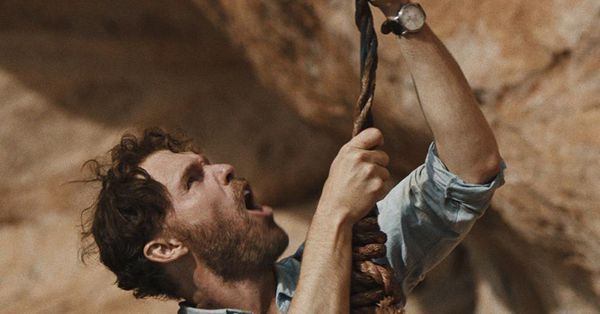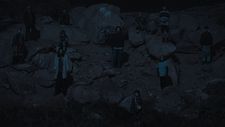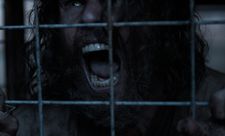 |
| Scott Haze in The Seeding |
A film set mostly in a single location which is vast in its ambition and existential scope, The Seeding screened at Tribeca earlier this year and is now part of the Frightfest line-up. Back in June I spoke with star Scott Haze, who plays the hapless hiker led astray by a mysterious child who finds himself trapped in a crater in the desert. Shortly afterwards I also met director Barnaby Clay. We spoke about the development of the story, its stunning location, the challenges of the shoot and the tricks which he used to bring depth to his supporting characters.
Barnaby, who trained in London, is pleased to hear that I’m in Paisley, which I identify by way of its famous abbey which features a gargoyle in the style of one of HR Giger’s aliens. He tells me that back in his film school days he actually travelled to Glasgow, eight miles from me, to film a science fiction short with an alien in it. Part of the project took him up to the Ben Nevis area, another hundred miles north.
“I shot my friend wearing this big alien head and carrying what basically was a boiler on his back. It was supposed to be a jet pack. But climbing up the mountain was very dramatic for a short, 16mm film, but it looked great.”
The story of The Seeding came to him when he was spending a lot of time in the desert, he says.
“There wasn't specifically a location I had in mind. We spent two years searching all over the world. We were considering Lanzarote, we considered these big quarries and an extinct volcano in Romania, we looked in northern Mexico, we really searched everywhere. And then suddenly we got this bunch of stills from a locations guy in Utah, and it was just beautiful. We made a lot of it in post, like the actual enclosing part, but what we had there was a 280 degree curve in this canyon, which gave us a lot of room to move within it. And it felt very much like we were enclosed, because we really, really wanted to shoot this on location and wanted it to feel like we also were trapped in there. We basically were for three weeks.”
I explain that Scott told me it was a horrible location to get in and out of.
“Oh my god, it really was,” he says. “I mean, it was it was horrible. And it was also one of the most beautiful drives in every morning, driving into this canyon. It's absolutely stunning, and you see deer running around and it's nature at its finest. But also, obviously, it was this windy road, you get stuck in mud, you get stuck in sand, and it snowed a week before we shot there so everything just down the road – that tiny road which wasn't really a road – got washed away.
“It was a very, very intense physical experience, but also, driving in in the morning, as the writer and director, you're filled with fear of what's going to go wrong today.” He laughs. “It was the drive of death for me, but certainly when I first actually went to visit that location it was very special. It’s really unusual. I became obsessed by the textures of the walls. From the very beginning I felt like the third character of the film was the location itself, so it was so important that we got it right.
“Getting it right meant physically working down on the ground, but also I had to be able to place the boys up on the ridge, and be able to shoot between the two of them. A lot of the places we saw were great but you couldn't get up there, and once you were up there, it was very dangerous. This was still dangerous and they still had rigs and harnesses and whatnot when they were up there. But the other thing about that location was that it’s just stunning surrounding it, so all those scenes at the beginning of the film really were shot within a half hour radius of the canyon. So you have the same kind of rock and everything looks natural like that.
 |
| The Seeding |
“We were shooting this other place which was really near – we were going to shoot one of the scenes where he meets the boy in these sand dunes, and it was just like, in that area, it's kind of near the Grand Canyon, and near Zion Canyon as well. And it's just so different. It's all desert, but it's just very different, and so there's just so much to choose from. I also like it because there’s a rich history of filmmaking down there. The funny little motel that we stayed in had a picture of all the Western stars that went down there. I think the last one was a while ago, like The Outlaw Josey Wales or something.”
I mention that, as I said to Scott, it reminded me a lot of classic Seventies science fiction films.
“Definitely,” he agrees. “There were a lot of Seventies Australian films that we thought about, like Wake In Fright, Walkabout, Picnic At Hanging Rock, I think because again, location plays such a key role in all those films. It's become this elemental situation of man versus nature, which is such a part of this film. I find that endlessly inspiring.”
I point out that those are all quite small, theatrical films in terms of the characters, but they have enormous themes and they use landscape to speak to that. Is that what he was aiming for here?
“Absolutely. 100%,” he says. “You know, when I was casting it, as happens many times with films, there was one point when we had a completely different cast, but then the financing fell through so we had to recast. I remember one actor read it and said ‘This is kind of like a fable.’ That's how he saw it and I think he was right in a way. I liked this idea of it being a small, very contained story, but dealing with some big, primal themes. That's why I was tying in the eclipse as well. Everything ties together.”
The score makes a big contribution to that mood. How did it come about?
“I love the score,” he says, pleased that I picked up on it. “It was done by Tristan Bechet, who's my cousin. Obviously we've known each other all our lives. We also have worked together on and off over the years. He used to be in experimental noise bands in New York, back in the late Nineties, early 2000s, and then he got more into scoring shorts and commercials. He did a lot in the fashion world for a long time. But he has just a very interesting language that he works with. I knew that he would immediately get the tone.
“Five years ago he started on the first draft, he started sending me stuff. Before I shot anything for the film, we had 20 pieces of music, which was great, because I was still writing listening to his music. It was about getting something primal.
“He has this industrial background. He approached two people that he's worked with in the past, who are, again, from the avant garde world. One of them, FM Einheit from the band Einstürzende Neubauten, he's based in Cologne, he's kind of a legend in that world. He brought in a lot of the noises. They're very unusual. He's playing the big springs you get on semi trucks, hitting them and getting all the sounds from them. And then he does this other thing where he pours sand and mixes it with glass and moves it around on big sheets of steel.
Then there was this girl who played cello, but again, it's very intense. They're all just shooting into these desert themes, loneliness and the abrasion of being out there in the desert alone, against everything. And yeah, the music was key. It was great to work with Tristan. At the very beginning I played the cast some music as well, just to give them a feel for it, which was very helpful, I think.”
Picking up on his mention of the fashion industry, I ask how involved he was in the development of the costumes for the feral boys in the story, which do a lot to help establish their individual characters even when we see them at a distance and as part of a mob.
“I was pretty involved with it,” he says. “We had certain limitations for building within the film, not just with the costumes, but also with the production design. I didn't want the children to be just wearing rags. It’s like they found this stuff on the side of a freeway, you know? They’ve dived into a skip at the back of the gas station, gone through it and pulled out somebody's old t shirt, but I didn't want it to feel like it's just old stuff.
“When we were putting references together, especially for the wardrobe, there was a lot of references to Romany kids, because you see them and they actually have a really great style. It’s such a mix of clothing. The other thing we spoke about was the idea that because they're alone a lot of the time, they're a bit more gender fluid. They might say ‘Oh, there's a dress. I'm going to wear the dress,’ and it has less connotations, it’s more just like ‘This is cool.’ I liked that.
“We really wanted to give each one of them that thing, you know? Lepus has his little hat and the little one has this little purse, and Corvus has this black suit because he’s the oldest. He must have some feel some level of responsibility, even though it's this tacky, old suit. We really did want to give each one their own distinct character, but also make it feel like it's just stuff they could find and it is real, not overly styled.”
 |
| Scott Haze in The Seeding |
That seems to apply with the set as well, I say.
“Yeah, well, obviously, we built that. The frame of it was built in Salt Lake City and then it was trucked down, and somehow we got it rolled into the canyon. They put all the pieces together and built it and in about three days, there was this house that looked like it had been there forever.
“I had a lot of discussions with David, my production designer, in advance, about the style of the place. We wanted to feel like it was a relic, maybe it was something work related at one point, like a quarry office. We wanted everything that was in that to not just feel like it was 100 years old. There's a microwave in there, but it's one which actually doesn't work. It’s used as storage. It's all stuff that the kids find and bring.
“When you drive through the desert here in California, you will see a bunch of junk on the side of the road. That’s the kind of stuff that they will have picked up, dragged back there and lowered down for her. It all tied into the story of like, of her existence down there and how it evolved, and then there are some things which are a little bit more special that should be passed down through the generations.”
I observe that there seem to be quite a few sort of little clues to her past lying around there as well.
“Yeah, yeah, there are clues in there, and then we have the murals outside, that she's painted, which also give different clues to the story and her background. When I was writing the whole film, I always wanted to have this sense of like, as crazy as this is, this could actually be real. Whenever I got to a situation where I felt like it was just too weird, some awful news headline would pop up about a family who kept the children in the basement or whatever, and I was just like, ‘This is America.’” He shrugs. “Crazy stuff happens here, unfortunately.
“I've been working on this for...” He trails off, thinking. “I got the idea when my wife was pregnant with my son. He's now about eight, so it was a long time ago. It's wild to live with a story for so long and then one day find yourself in Utah, standing in a canyon with this set which is suddenly being built, which is the set that you've had in your mind for four years already.
“I have no idea what people are going to think of it. It's hard to have much perspective when you look at your own work. It's hard to be to really see it for what it is. I watched it late one night recently, and I felt pretty good about it. I want to hold onto that feeling for as long as I can, but I'm really excited for people to see it.”
I tell him that I think it will do well, if only because it’s so unusual these days. It really stands out.
“I hope so,” he says. “I think it's unique. It's its own thing, and it's compelling, and I'm very happy. I think both Scott and Kate [Lyn Sheil] were fantastic. They delivered such powerful performances. Working with the kids was great. They were lovely, such fun, you know? It was a really tough shoot, but ultimately some of the intensity on set has to imprint itself on the film, it can't escape. There's got to be some visceral nature in the in the final film. I’m happy about that.”





















